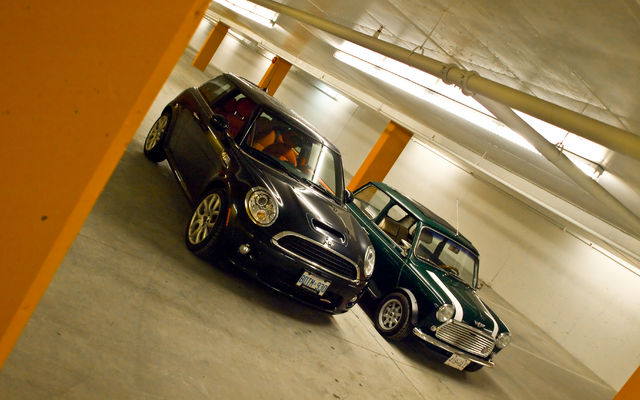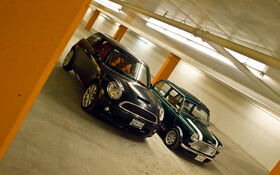2009 Mini John Cooper Works: Better than the original?
There are a few hallowed names in the world of automotive tuning. BMW’s M division, Mercedes’ AMG, and Audi’s Quattro may perhaps be the three best known; lusted after for their uninhibited performance and impressive cachet. But for historical value, none can hold a candle to the name affixed to the rear hatch of a vehicle with a sticker price that is nigh half of that trio’s cheapest offerings: John Cooper Works.
Lending his name most famously to the British Motor Company’s Classic Mini (hereby creating the famous Mini Cooper model), John Cooper’s performance lineage easily predates his Classic Mini’s four-year dominance of the Monte Carlo rally from 1964 to 1966. Earning his name in the post World War II era of F1 racing by engineering the very first rear-engined Formula 1 car, John Cooper started up John Cooper Works in 2000, looking to once again bring the then-new BMW Mini to new performance heights. Sadly, John Cooper passed away shortly after, leaving the company to his son Michael. In 2007, BMW purchased the brand outright, saying it was “strong enough to be developed as a good sub-brand.”
Today, that sub-brand is responsible for the fastest Mini that you can buy in this country. Known simply on Mini’s website as the Mini John Cooper Works and as a JCW in enthusiast circles, the John Cooper Works package thoroughly transforms the stock Mini Cooper S into a vehicle of a completely different ilk. Opting to make the majority of the design changes in the traditional way, the JCW thankfully shies away from parent company BMW’s M-division and their reliance on copious go-fast electronics. Instead, a revised cylinder head and pistons make better use of the increased boost from the twin-scroll turbocharger, leading to 36 more horsepower and up to 30 more lb-ft of torque (in overboost mode) over the Mini Cooper S. Now totalling 208 and 207 respectively, the JCW’s horsepower and torque figures top even those provided by the second place finisher of 1965’s Monte Carlo rally: a race-prepped Porsche 904.
Of course, power was never supposed to be a Mini’s forte. With a ridiculously low amount of weight carried by wheels slung out to the far reaches of the car’s diminutive footprint, the Mini’s handling is best defined as legendary. While the old one relied on its tossability and size to keep it ahead of the pack, the new one uses modern suspension and tire technology to keep its 2,701 lbs glued firmly to the pavement. Where the old one was all lifting-throttle oversteer, the new one requires copious amounts of trail braking to release the rear tires’ grip on the Earth’s crust. But how different is this new, hottest-Mini-ever from a Classic Mini? Well, conveniently enough, yours truly managed to procure one to ascertain the answer to that question.
Parked alongside the spry form of a 1979 Classic Mini, the difference between the old and the new Mini is pretty obvious; and it’s about a foot in every direction. Getting in, the Classic’s door shuts as positively as the JCW’s, albeit without the massive weight of the side-impact structures and width. However, turning the key greets with a far more mechanical thrashing from the transplanted 1,380 cc transverse four cylinder than you get in the Mini’s silky smooth powerhouse. Engage first gear, step on the clutch, move your foot to the spot where the gas pedal should be (and is in the JCW, by the way), and then move your foot 6” to the right, where the gas pedal actually resides. Everything engages in the smooth, mechanical manner you’d expect of such a simplistic machine, although the bizarre, near-horizontal steering wheel takes some getting used to, especially after getting acclimatized to the JCW’s adjustable column.
Moving down the road, the Classic Mini pulls quite well, and the reduction in weight over the JCW’s comparatively massive girth becomes immediately apparent. Rounding corners, the steering provides infinitely more feedback, while the expansive interior feels (and is) quite a bit larger than the JCW’s safer, more robust cocoon. But how does the JCW compare?
Well, the single largest knock against the current crop of Mini’s is their lack of character. Even in it’s most basic trim, the Classic Mini was a blast to drive, while the basic Mini Cooper is little more than economical and stylish transportation that provides an uninspiring driving experience. Opt for the Mini Cooper S variant, and you get a premium hot hatch that is amazingly capable, but in being so, lacks the quirky character that only misplaced pedals and bus-style, relatively unassisted steering can provide. And while the JCW has none of those quirky attributes, it combines the practicality of the Mini Cooper with the fun quotient of the Mini Cooper S, and adds a dose of character by virtue of its enhanced performance. Can you feel each of the36 more horsepower when you give it a bit of welly, as the English would say? No, obviously not; all that power is tempered by over a ton of weight after all. But what you do feel is an incredible surge of acceleration, while the ridiculous amounts of torque being applied to the front tires makes the leather of the perfectly placed steering wheel dance in your hand. Bend the car into an apex, manipulate the pedals just right, and you’ll be rewarded with juvenile delinquent levels of oversteer, and the most incredibly satisfying crackling backfires. Shifting through the gears as you rocket out of a corner, and passersby will be treated to a cacophony of tire squeal, excess fuel exploding in the exhaust, and finally, a pleasing pop, as the blow off valve vents excess boost out of the intake system for the next shift through the gearbox.
So, does the JCW live up the legend? Yes, but in a thoroughly modern way. It trades the character gleaned from the original’s quirky construction and enthusiastic performance for the kind of character that comes from its pairing of incredible capability with the fun of overzealous high-octane backfires, retina-depressing immediacy under the predictably placed gas pedal, and a symphonic coupling of exhaust and turbocharger noise. The tactile sensations are still there just as they were decades ago, they’re just in all the right places now.












